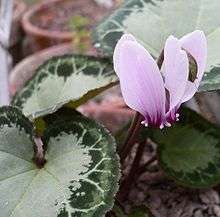Cyclamen graecum
| Cyclamen graecum | |
|---|---|
 | |
| Scientific classification | |
| Kingdom: | Plantae |
| (unranked): | Angiosperms |
| (unranked): | Eudicots |
| (unranked): | Asterids |
| Order: | Ericales |
| Family: | Primulaceae |
| Genus: | Cyclamen |
| Subgenus: | Cyclamen |
| Series: | Persicum |
| Binomial name | |
| Cyclamen graecum Link | |
Cyclamen graecum, the Greek cyclamen,[1] is a perennial growing from a tuber, native to southern Greece, southern Turkey, and neighboring islands and prized for its variable leaf forms, which include some of the most striking of any cyclamen.
Distribution
Cyclamen graecum native to a wide variety of areas up to 1,200 m (3,900 ft) elevation in southern mainland Greece, the Peloponnese, Aegean Islands, Crete, the southern coast of Turkey, and northern Cyprus
Description
The tuber is corky, with thick, strong, fleshy anchor roots sprouting from the center of the bottom.
Leaves are heart-shaped and toothed.
Flowers bloom in autumn and have 5 petals, white or pink with a darker blotch at the nose. They are often fragrant. The bases of the petals are curled outwards into auricles, like Cyclamen hederifolium.
After pollination, the flower stem coils both directions, starting from the center, not from the top as in Cyclamen hederifolium.
Subdivisions
Subspecies
Cyclamen graecum has three subspecies, distinguished by flower characteristics:
- Cyclamen graecum subsp. graecum — pink flowers with a darker blotch at the nose (Greece, Aegean islands, Crete)
- Cyclamen graecum subsp. graecum f. album — all-white flowers (Peloponnese, Rhodopou Peninsula of Crete)
- Cyclamen graecum subsp. anatolicum Ietsw. — more slender flowers with a smaller blotch and slight auricles (southern Turkey, Rhodes, northern Cyprus)
- Cyclamen graecum subsp. mindleri Hildebr. (or candicum Ietsw.) white or pale pink flowers with more pronounced auricles (western Crete)
References
- ↑ "BSBI List 2007". Botanical Society of Britain and Ireland. Archived from the original (xls) on 25 January 2015. Retrieved 2014-10-17.
External links
| Wikimedia Commons has media related to Cyclamen graecum. |
| Wikispecies has information related to: Cyclamen graecum |
- Cyclamen Society
- Cyclamen graecum (Monthly feature article);
- photos of tuber (Bulb Log 31, 30 July 2008) — Scottish Rock Garden Club
- Pacific Bulb Society
- photos — Flickr search
- IPNI Listing
- Gallery of the World's Bulbs — International Bulb Society (photo of tuber)
- Kew Plant List
